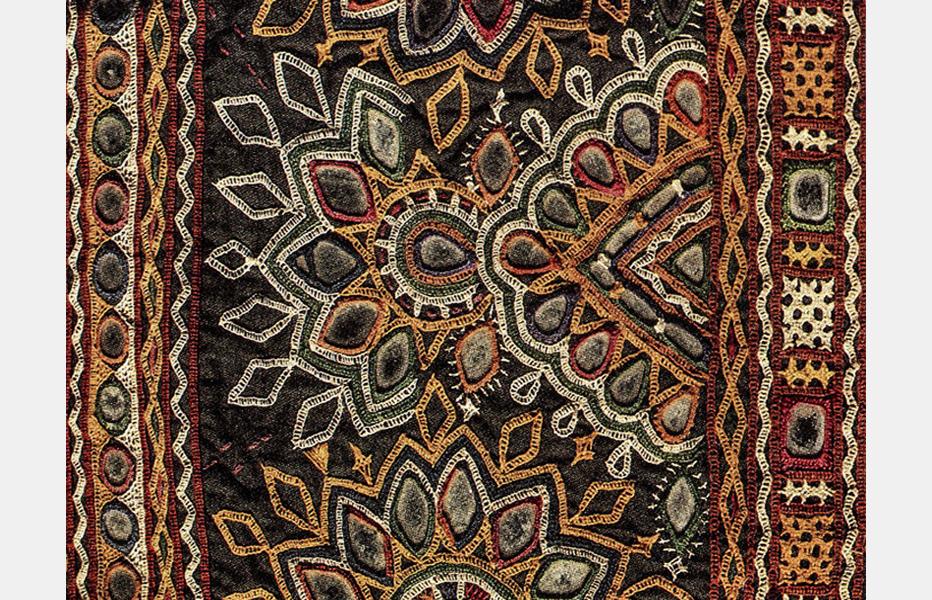Traditional Crafts used in the Collections
G-20 Fashion Home Page | Vayu (Air) | Shuchi (Fire) | Dhara (Earth) | Jal (Water) | Nabha (Sky)
Craft Name: Rabari Embroidery
Location: Bhuj, Kutch, Gujarat
Community: Rabari
Similar Crafts in the world: Lambani
Rabari embroidery gets its name from the Rabari community of Bhujodi, Kutch who were a nomadic/semi-nomadic community of cattle rearers belonging to the western region of India, from Rajasthan to the Kutch region in Gujarat.
Mirror chain stitch in various sizes and shapes is the distinctive feature of Rabari embroidery, giving it a unique and beautiful style. Women use their creativity, and aesthetics through their embroidery work on textiles.
The girls in the Rabari community learn and start embroidery work, from an early age to prepare their own bridal trousseau, torans (doorway hanging), shawl, bags, bedcovers and decorative camel covers for their future husbands and family. The women also embroider their everyday garments like kanchali (backless blouses), paheranu (wrapped skirts), ghagharo (stitched skirt), and ludi (woollen veil).
Process:
- The artisan creates traditional patterns with chain stitches and liberal use of mirrors. The varieties in this embroidery are mainly observed in the placement of the mirrors and the fascinating stitches made along the borders. Glass mirrors are used in various shapes like round, diamond, rectangle, square, and triangle.
- The women depict their everyday life and the world around them, through their embroidery.
- Chain stitch (shankari) accompanied by an array of accent stitches adds a graphically illustrative quality to their needlework.
- The back stitch locally known as ‘bakhiya’ adds a lot of emphasis to the creative work.
- Contrasting and non-repetitive use of colours is one of the most distinctive characteristics of Rabari embroidery.
- The style of the embroidery is not static as these stitches and colours change as per the spontaneity and imagination of the artist.

Source :
Handmade in India, Aditi Ranjan & M. P. Ranjan
https://www.dsource.in/sites/default/files/styles/gallary_images__565_x_800__/public/gallery/4517/12.jpg?itok=vjZKNYSR&c=f97a926d000beac8b8adaea9a342e1c1
https://dsource.in/resource/rabari-embroidery-bhujodi/making-process
https://dsource.in/resource/rabari-embroidery-bhujodi/introduction
Craft Name: Zardozi Embroidery
Location: Bhuj, Kutch, Gujarat
Community: Muslim Community
Similar Crafts in the world: Metal Embroideries
Zardozi is a form of hand embroidery, that originated in Persia whereas “zar” means gold and “dozi” means embroidery. The embroidery involves the decoration of fabric with a special hook needle, metallic threads, colourful yarn, pearls, beads, quills, sequins etc.
The Mughal conquerors introduced this heavy and unique style of hand embroidery to India. In the Mughal era, zardozi work was used to decorate tent walls in the form of wall hangings as well as accessories for royal elephants and horses. Zardozi's workmanship differs from other traditional Indian embroideries like chikankari, sujni, kantha, kasuti, toda etc.
Traditionally, the Muslim communities residing in different parts of India executed zardozi work. The zardozi designs and subjects vary in different parts of the country.
Process:
- The plain fabric that has to be embroidered is framed tightly to the round or rectangular wooden frame.
- The required patterns or designs are created directly on the fabric with the tailor’s chalk or transferred through tracing paper.
- The artisan starts with an aari chain stitch. The stitches are done by holding the thread with a finger at the reverse of the framed fabric and an aari hook, a sharp-pointed awl-like needle, held on the top.
- The aari hook is pierced through the cloth to pull up the thread from the backside of the framed cloth and each stitch new stitch tightens the previous one.
- These stitches are similar to the cobbler’s stitch and the process of embroidering is repeated until the required design is formed on the surface of the fabric.
- Sequins, beads or twisted metallic wires maybe used additionally to enrich the embroidery.

Source :
https://www.dsource.in/resource/aari-zardozi-ahmedabad-gujarat/making-process
https://www.dsource.in/resource/aari-zardozi-ahmedabad-gujarat/introduction
https://4.bp.blogspot.com/-zSNZ2RKrEvc/Ur1pZDnuS1I/AAAAAAAAKnw/eX0NN4g5PXc/s1600/zardozi+peacock.jpg

